Evolutionary Path and Sustainable Optimization of an Innovation Ecosystem for a High-Tech Enterprise Based on Empirical Evidence from Hubei Province
Abstract
1. Introduction
2. Formation and Elements of a High-Tech Enterprise Innovation Ecosystem
2.1. The Formation of the Innovation Chain of a High-Tech Enterprise’s Innovation Ecosystem
2.2. Elements of a High-Tech Enterprise Innovation Ecosystem
3. Evolutionary Paths of a High-Tech Enterprise Innovation Ecosystem
3.1. Competitive Evolution
3.2. Cooperative Evolution
4. Optimization of the Evolutionary Path of a High-Tech Enterprise Innovation Ecosystem
4.1. Measurement of the Evolution Effect of a High-Tech Enterprise Innovation Ecosystem
4.1.1. Research Method
4.1.2. Research Design
- (1)
- System Boundary and Condition Assumptions
- (2)
- Causality of a High-Tech Enterprise Innovation Ecosystem
- (3)
- Feedback Mechanism of a High-Tech Enterprise Innovation Ecosystem
- (4)
- Empirical Evidence from Hubei Province
4.2. Optimization Design of Evolutionary Path of a High-Tech nterprise Innovation Ecosystem
4.2.1. Increase Investment in System Innovation
4.2.2. Optimizing the Innovation Ecological Environment
5. Conclusions
Author Contributions
Funding
Institutional Review Board Statement
Informed Consent Statement
Data Availability Statement
Acknowledgments
Conflicts of Interest
References
- Su, Y.; Zheng, Z.; Chen, J. A Multi-platform Collaboration Innovation Ecosystem: The Case of China. Manag. Decis. 2018, 56, 125–142. [Google Scholar] [CrossRef]
- Xu, N.; Xu, Y. The Co-evolutional Mechanism on Resource, Innovation Network and Reverse Innovation of Latecomer Enterprise: A Research on Haier Group. Manag. Rev. 2016, 28, 216–228. [Google Scholar]
- Adner, R.; Kapoor, R. Innovation Ecosystems and the Pace of Substitution: Re-examining Technology S-curves. Strateg. Manag. J. 2016, 37, 625–648. [Google Scholar] [CrossRef]
- Zahra, S.A.; Nambisan, S. Entrepreneurship and Strategic Thinking in Business Ecosystems. Bus. Horiz. 2012, 55, 219–229. [Google Scholar] [CrossRef]
- Moore, J.F. The Death of Competition; Beijing Publishing House: Beijing, China, 1990; pp. 77–86. [Google Scholar]
- Huang, L. Regional Technological Innovation System: A Ecology Perspective. Stud. Sci. Sci. 2003, 21, 215–219. [Google Scholar]
- Mei, L.; Chen, J.; Liu, Y. Innovation Ecosystem: Origin, Knowledge Evolution and Theoretical Framework. Stud. Sci. Sci. 2014, 32, 1771–1780. [Google Scholar]
- Fan, X.; Jia, J.; Meng, Y. The Study of Innovation Ecosystem Evolution and Development. Chin. J. Manag. 2018, 15, 151–158. [Google Scholar]
- Kayano, F.; Chihiro, W. Japanese and US Perspectives on the National Innovation Ecosystem. Technol. Soc. 2008, 30, 49–63. [Google Scholar]
- Zeng, G.; Gou, Y.; Liu, L. From Innovation System to Innovation Ecosystem. Stud. Sci. Sci. 2013, 31, 4–12. [Google Scholar]
- Yang, L.; Shang, C.; Yang, J. Dissipative Evolution of Regional Innovation Ecosystem from the Perspective of Symbiosis Theory. Sci. Technol. Prog. Policy 2022, 12, 1–11. [Google Scholar]
- Zahra, S.A.; Nambisan, S. Entrepreneurship in global innovation ecosystems. AMS Rev. 2011, 1, 4–17. [Google Scholar] [CrossRef]
- Yan, M.; Chien, K.; Hong, L.; Yang, T.N. Evaluating the collaborative ecosystem for an innovation-driven economy: A systems analysis and case study of science parks. Sustainability 2018, 10, 887. [Google Scholar] [CrossRef]
- Xie, X.; Yu, S.; Wu, Y. Research Hotspots and Evolution Path of Foreign Innovation Ecosystem: Based on the View of Mapping Knowledge Domains. Sci. Sci. Manag. S. T. 2020, 41, 20–42. [Google Scholar]
- Salavisa, I.; Sousa, C.; Fontes, M. Topologies of Innovation Networks in Knowledge-intensive Sectors: Sectoral Differences in the Access to Knowledge and Complementary Assets though for Maland in Formalties. Technovation 2012, 32, 380–399. [Google Scholar] [CrossRef]
- Li, F.; Zeng, G. The Health Connotation and Evaluation Analysis of Innovation Ecosystem. Soft Sci. 2015, 29, 1–4. [Google Scholar]
- Holgersson, M.; Granstrand, O.; Bogers, M. The evolution of intellectual property strategy in innovation ecosystems: Uncovering complementary and substitute appropriability regimes. Long Range Plan. 2018, 51, 303–319. [Google Scholar] [CrossRef]
- Wang, Z.; Tang, Z. Study on Dissipative Structure of Regional Innovation Ecosystem. Stud. Sci. Sci. 2021, 39, 170–179. [Google Scholar]
- Johne, A. New Style Product Development. Manag. Decis. 1992, 30, 8–11. [Google Scholar] [CrossRef]
- Wang, G.; Yang, H.; Wang, C. Comparative Analysis of the Evolution of Innovation Ecosystem Research Domestic and Overseas: Theoretical Retrospection, Hot Spot Discovery and Integration Prospect. Sci. Technol. Prog. Policy 2021, 38, 151–160. [Google Scholar]
- Song, H.; Chen, S. How to Build a Healthy Innovation Ecosystem in High-tech Industry? A Perspective Based on Core Competency. Manag. Rev. 2021, 33, 76–84. [Google Scholar]
- Adner, R. Match Your Innovation Strategy to Your Innovation Ecosystem. Harv. Bus. Rev. 2006, 84, 98–107. [Google Scholar] [PubMed]
- Liu, J.; Xie, R. Innovation Ecosystem: Conceptual Differences, Root and Further Discussion. Sci. Technol. Manag. Res. 2020, 40, 8–14. [Google Scholar]
- Liu, H.; Liu, Q. The Co-evolution Mechanism of the Innovation Ecosystem of High-tech Industry. J. Technol. Econ. 2021, 40, 99–106. [Google Scholar]
- Zhou, J.; Tan, J. Innovative Behavior Differentiation between High-Tech Enterprises and High and New Technology Enterprise. Shanghai J. Econ. 2017, 1, 68–76. [Google Scholar]
- Gao, S.; Tan, J. The Continuous Evolution Mechanism of Innovation Ecosystem-based on Government and Firm View. Stud. Sci. Sci. 2021, 39, 900–908. [Google Scholar]
- Tan, J.; Song, J.; Chen, X. The Formation and Evolution of Industrial Innovation Ecosystem: “Architect” Transition and the Evolution of Its Strategic Behavior. Manag. World 2021, 37, 167–191. [Google Scholar]
- Wang, S.; Chen, W. Regional Association Analysis on the Growth of Enterprise Innovation Population Based on the Grey Population. Math. Pract. Theory 2021, 51, 10–17. [Google Scholar]
- Fan, X.; Jiang, N. Evaluation of Innovation Ecological Level of China’s High-tech Industry and Analysis of Its Influencing Factors. Ind. Innov. 2020, 17, 1–8. [Google Scholar]
- Ye, M.; Wang, K. Impact of government R&D Investment on Enterprise Innovation Performance—An Empirical Study Based on Shanghai High-tech Enterprises. Sci. Res. Manag. 2019, 40, 78–86. [Google Scholar]
- Fang, Y.; Liu, J.; Feng, X. Spatial Correlation, Innovation Ecological Environment and Efficiency of Industry Innovation Ecosystem: An Empirical Study based on High-tech Industrial of 23 Provinces in China. Sci. Technol. Prog. Policy 2022, 39, 59–68. [Google Scholar]
- Yin, J.; Liu, Y.; Li, F. Research on China’s High-tech Industry Innovation Efficiency from the Perspective of Innovation Ecosystem. Soft Sci. 2021, 35, 53–60. [Google Scholar]
- Radziwon, A.; Bogers, M.; Bilberg, A. Creating and Capturing Value in a Regional Innovation Ecosystem: A Study of How Manufacturing SEMs Develop Collaborative Solutions. Soc. Sci. Electron. Publ. 2016, 75, 73–96. [Google Scholar] [CrossRef]
- Zhao, X.; Liu, Y. Study on the Innovation Level of Science and Technology of High-tech Industries in Hubei Province. Sci. Technol. Prog. Policy 2017, 34, 133–140. [Google Scholar]
- Pan, H. The Evolution of Innovation Capabilities in High-tech Enterprises Based on Coupling of Environmental Regulation and Collaborative Innovation. Forum Sci. Technol. China 2017, 5, 87–93+100. [Google Scholar]
- Xiao, H.; Qin, J. Research on Evaluation of Innovation Capability Based on Heterogeneity Taking Guangdong High-tech Enterprises as an Example. Sci. Technol. Manag. Res. 2018, 8, 72–79. [Google Scholar]
- Yu, W.; Xiong, W. Research on the Stability of Knowledge Ecosystem and the Mechanism of Relational Governance-from the Perspective of Symbiosis Theory. J. Tech. Econ. Manag. 2020, 6, 31–35. [Google Scholar]
- Yang, W.; Lao, X.; Zhou, Q.; Zhang, L. The Governance Niche Configurations for the Resilience of Regional Digital Innovation Ecosystem. Stud. Sci. Sci. 2022, 40, 534–544. [Google Scholar]
- Ramezani, J.; Camarinha-Matos, L.M. Approaches for resilience and antifragility in collaborative business ecosystems. Technol. Forecast. Soc. Chang. 2020, 151, 119846. [Google Scholar] [CrossRef]
- Liu, D.; Dong, B.; Lu, Y. Research on Optimization of Zhejiang Digital Government Governance Innovation Ecosystem: Based on Case Analysis of Health QR Code and Enterprise QR Code. J. Zhejiang Univ. Technol. 2021, 20, 50–57. [Google Scholar]
- Fan, J. The Theoretical Logic and Management Mechanism of Innovation Ecosystem-From the Perspective of Life Cycle Evolution. J. Tech. Econ. Manag. 2017, 9, 32–36. [Google Scholar]
- Hu, Z.; Yu, F.; Wang, J. Enterprise Innovation ecosystem: From Research Review to the Design of Governance and Operation Theoretical Model. J. Guilin Univ. Aerosp. Technol. 2019, 1, 37–52. [Google Scholar]
- Hao, B.; Ren, H. Research on the Structure of Interenterprise Relations and its Symbiosis. Foreign Econ. Manag. 2009, 31, 29–37. [Google Scholar]
- Sun, C.; Wei, J. The Structure and Collaborative Mechanism of Firm-level Innovation Ecosystem. Stud. Sci. Sci. 2019, 37, 1316–1325. [Google Scholar]
- Baretta Bekker, J.G.; Baretta, J.W.; Rasmussen, E.K. The Microbial Food Web in the European Regional Seas Ecosystem Model. Neth. J. Sea Res. 1995, 33, 363–379. [Google Scholar] [CrossRef]
- Becks, L.; Hilker, F.M.; Malchow, H.; Jurgens, K.; Arndt, H. Experimental Demonstration of Chaos in a Microbial Food Web. Nature 2005, 435, 1226–1229. [Google Scholar] [CrossRef]
- Kooi, B.W.; Kuijper, L.D.J.; Boer, M.P. Numerical Bifurcation Analysis of a Tri-Trophic Food Web with Omnivory. Math. Biosci. 2002, 177–178, 201–228. [Google Scholar] [CrossRef]
- Perhar, G.; Arhonditsis, G.B. The Effects of Seston Food Quality on Planktonic Food Web Patterns. Ecol. Model. 2009, 220, 805–820. [Google Scholar] [CrossRef]
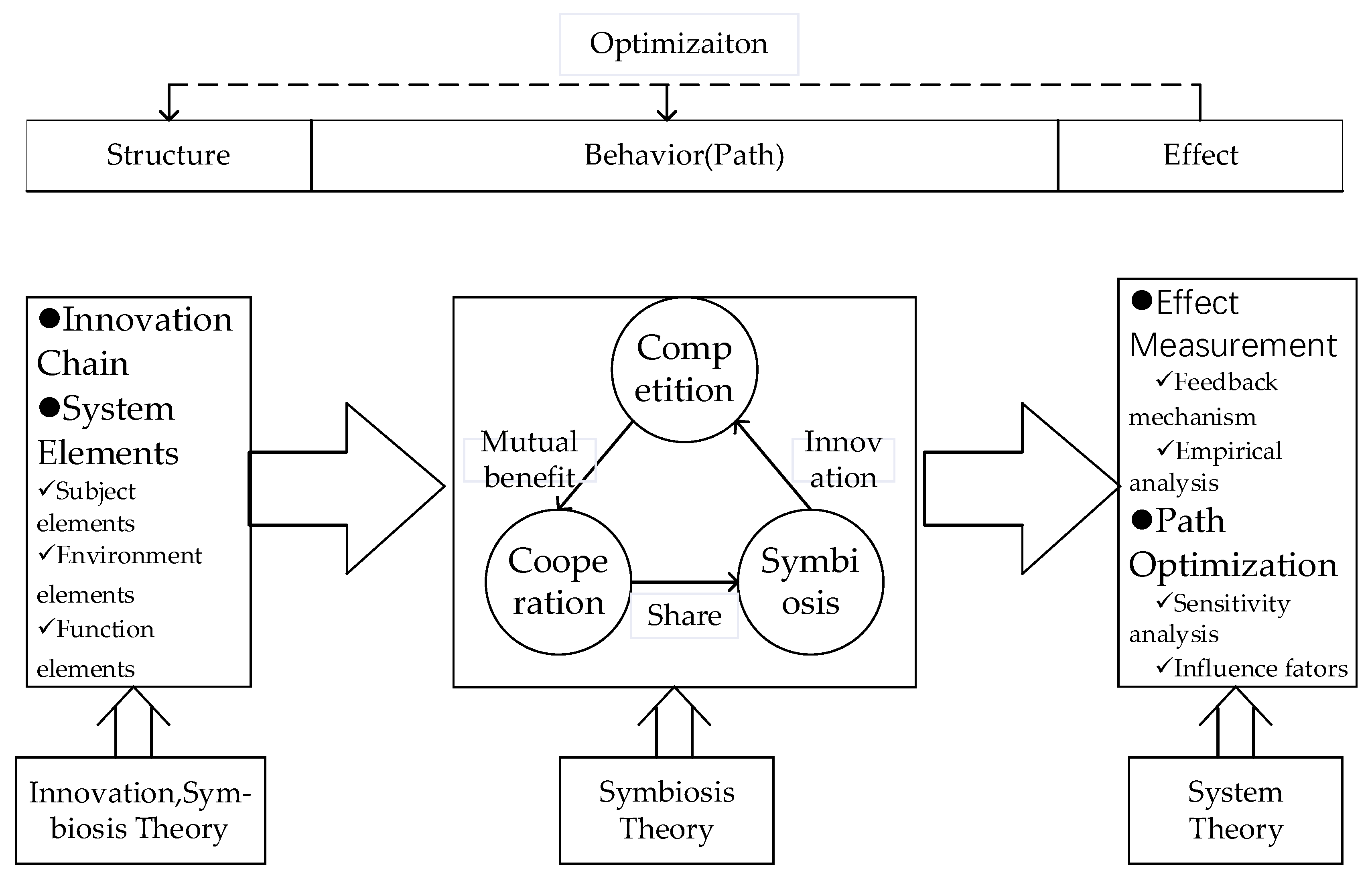
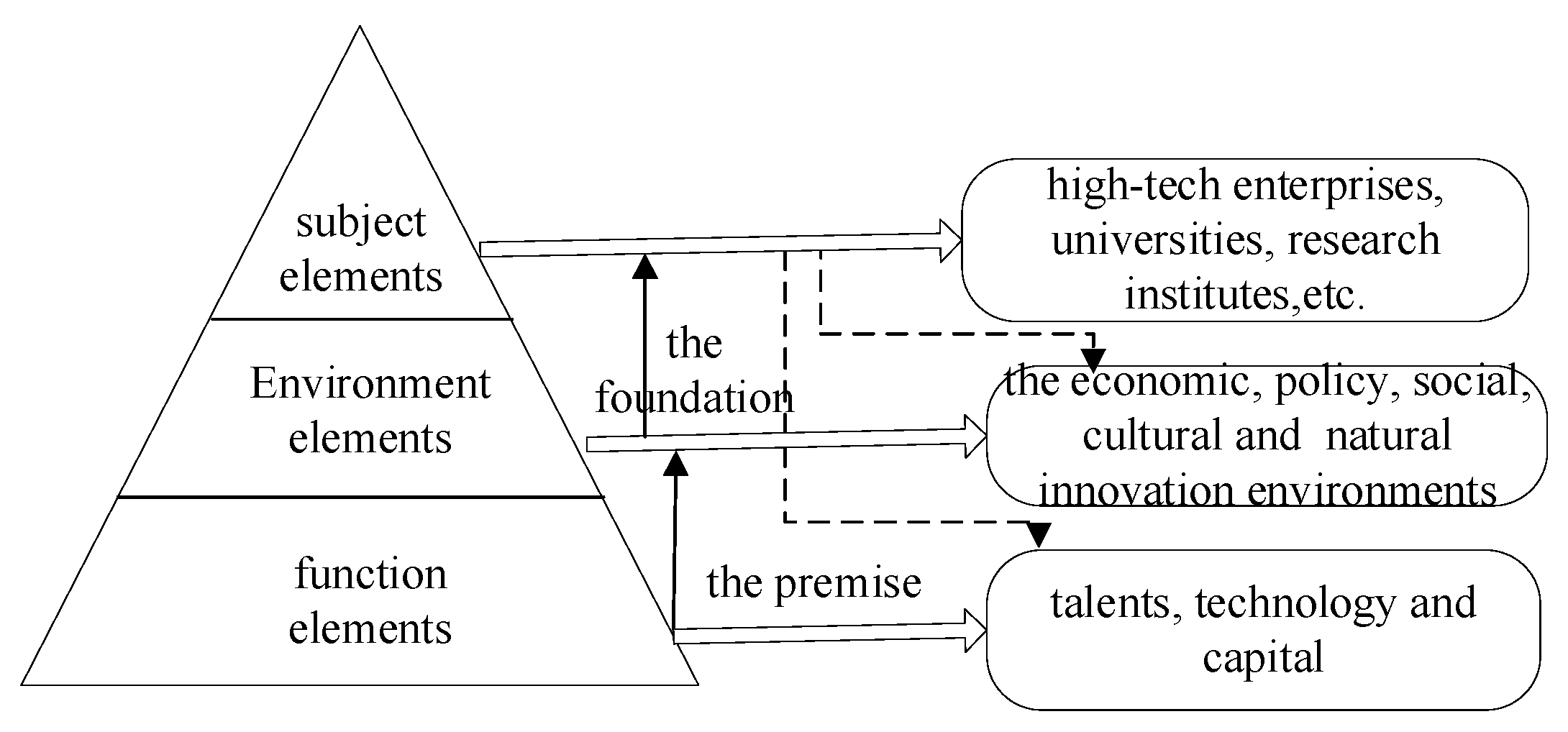

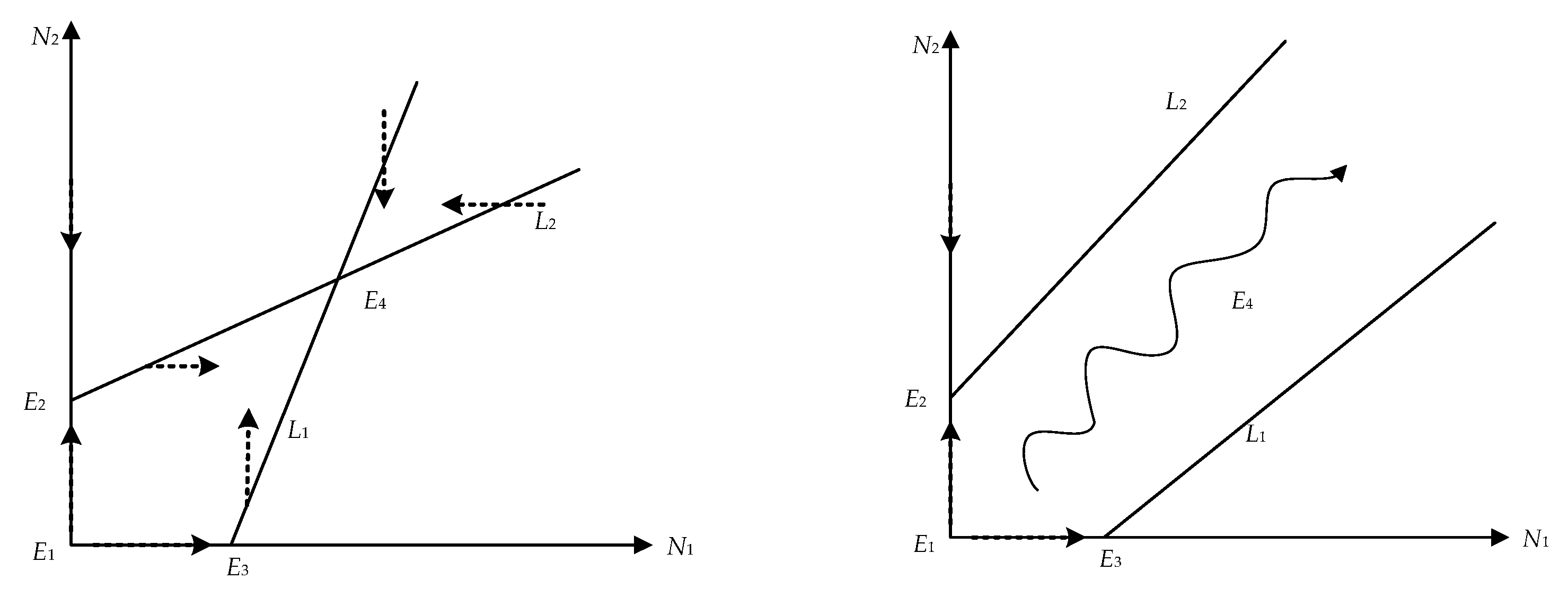
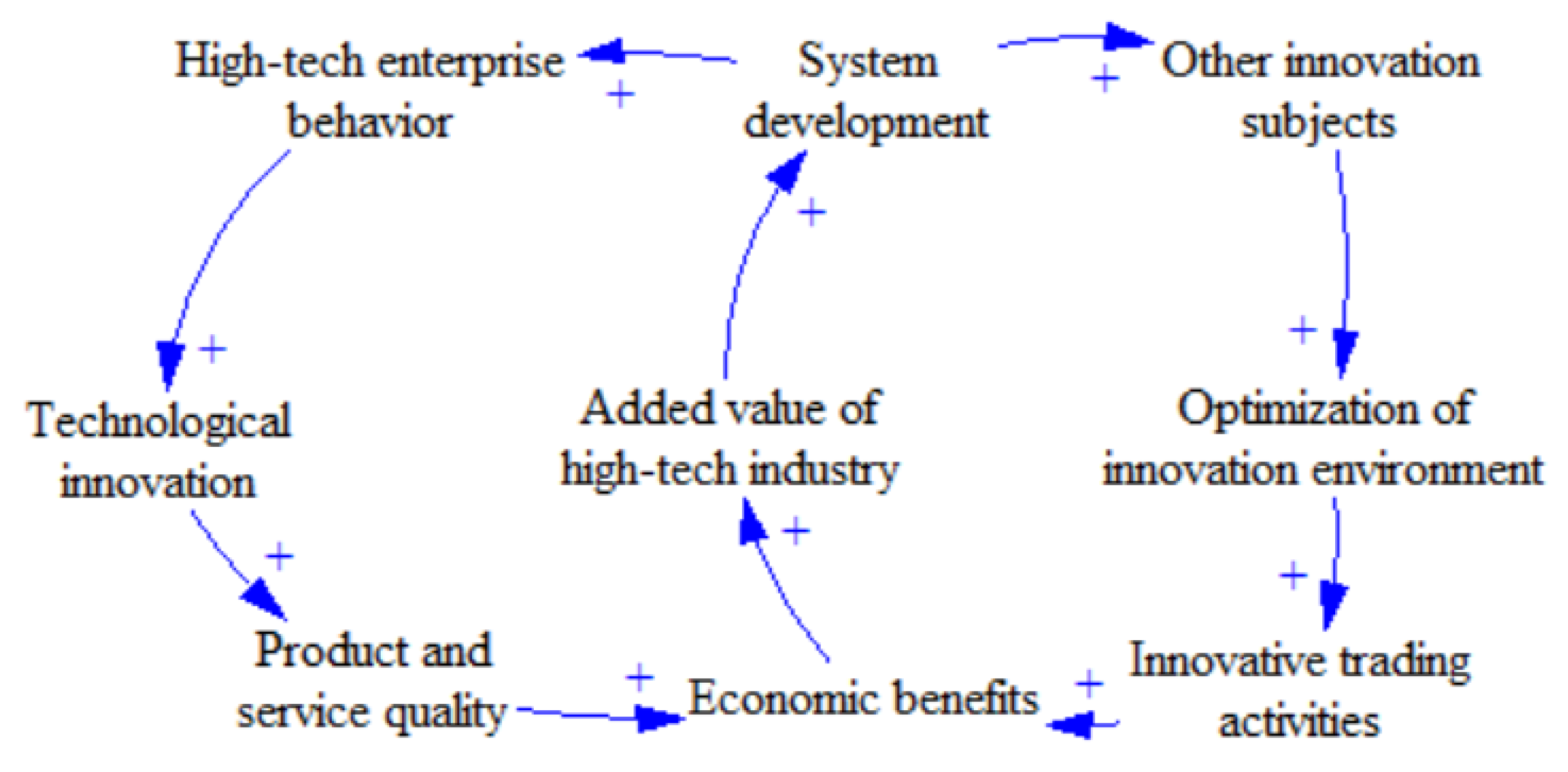
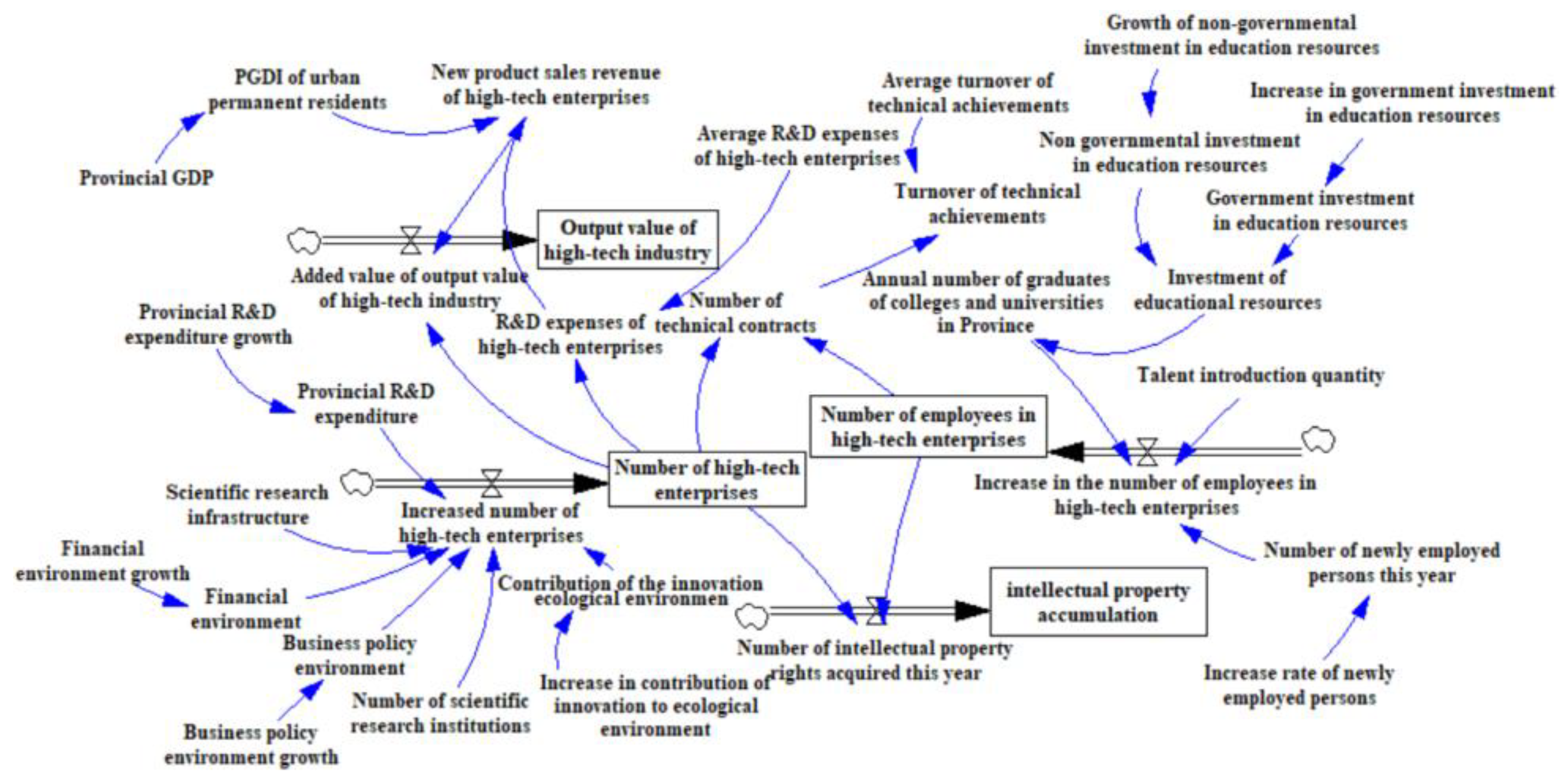
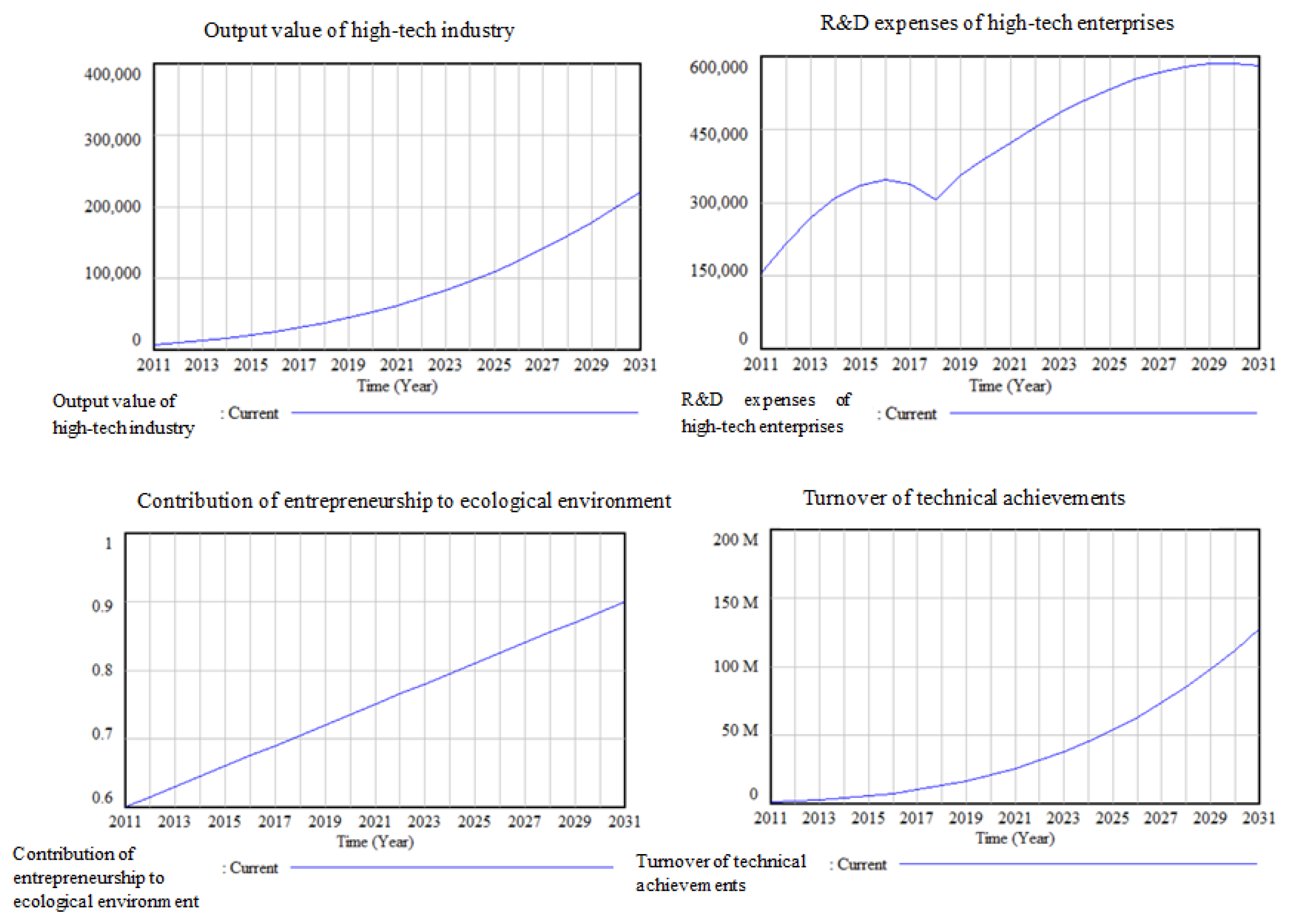

Disclaimer/Publisher’s Note: The statements, opinions and data contained in all publications are solely those of the individual author(s) and contributor(s) and not of MDPI and/or the editor(s). MDPI and/or the editor(s) disclaim responsibility for any injury to people or property resulting from any ideas, methods, instructions or products referred to in the content. |
© 2022 by the authors. Licensee MDPI, Basel, Switzerland. This article is an open access article distributed under the terms and conditions of the Creative Commons Attribution (CC BY) license (https://creativecommons.org/licenses/by/4.0/).
Share and Cite
Liu, A.; Cai, L.; Chen, F. Evolutionary Path and Sustainable Optimization of an Innovation Ecosystem for a High-Tech Enterprise Based on Empirical Evidence from Hubei Province. Sustainability 2023, 15, 770. https://doi.org/10.3390/su15010770
Liu A, Cai L, Chen F. Evolutionary Path and Sustainable Optimization of an Innovation Ecosystem for a High-Tech Enterprise Based on Empirical Evidence from Hubei Province. Sustainability. 2023; 15(1):770. https://doi.org/10.3390/su15010770
Chicago/Turabian StyleLiu, Aijun, Lu Cai, and Fan Chen. 2023. "Evolutionary Path and Sustainable Optimization of an Innovation Ecosystem for a High-Tech Enterprise Based on Empirical Evidence from Hubei Province" Sustainability 15, no. 1: 770. https://doi.org/10.3390/su15010770
APA StyleLiu, A., Cai, L., & Chen, F. (2023). Evolutionary Path and Sustainable Optimization of an Innovation Ecosystem for a High-Tech Enterprise Based on Empirical Evidence from Hubei Province. Sustainability, 15(1), 770. https://doi.org/10.3390/su15010770







